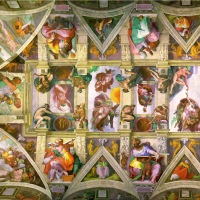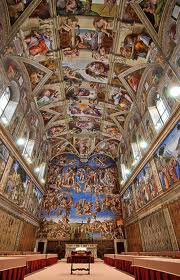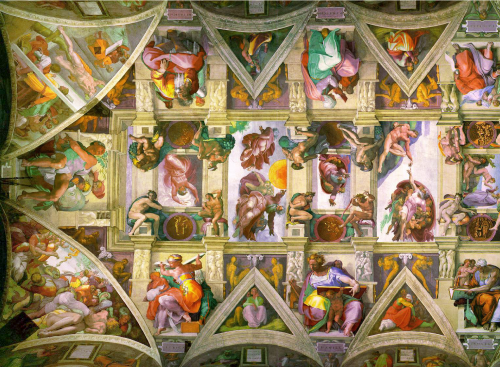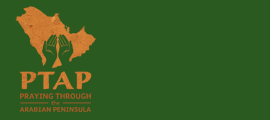Di Sotto in Su

 Advent week 3: This week I have been especially encouraged to pray. From below, looking upward.
Advent week 3: This week I have been especially encouraged to pray. From below, looking upward.
I have been reading about the life and work of Michelangelo Buonarroti. It is fascinating to learn about the techniques developed by the Italian Renaissance artists as they created frescos. I have often wondered if I should give it a go and try it myself. But the process of fresco design is far more complex than I ever believed possible and the skill and physical stamina required of the artist is extreme. Extreme art… Michelangelo once told his brother, Buonarroto, “I am living here in the greatest discomfort, in a state of extreme fatigue… I do nothing but work day and night, and have endured, and am enduring such fatigue that if I had to do the work over again, I do not believe I would survive”.
The plaster, called “intanaco” is applied in sections onto the wall. This is done because frescos can only be worked on while the plaster was wet. The artist plasters sections of canvas i.e. wall or ceiling for what he determines he can complete in one day, known as “giornata”, or a day’s work. If he becomes overzealous and applies too much plaster in the section, he is bound by the work to continue until it is completed, hence, the extended work day. However, if the artist mixes the plaster too soft, the colors will be cloudy; if it is too dry, a crust will form and pigments will adhere poorly, dimming the natural mineral sparkle and thereby necessitating the plaster and artwork to be chipped away and the process begun anew.
As acknowledged by Michelangelo himself, creating fresco is highly exacting. It also requires spreading a total of three layers of plaster on the wall. A rough undercoat of plaster is first applied and when dried, a cartoon is sketched onto the plaster using charcoal. These drawings are called “sinopia” and are then covered with another very fine layer of plaster. Pigment, the ‘paint’ if you will, is composed of ground stone or glass, soil and minerals, which is mixed with water and applied to the nearly dry plaster so that the pigment is bound to the wall via a chemical reaction. The palette or cacophony of color, actually “crystallizes” as the plaster dries producing the luminous matte finish that so aptly characterizes the essence of art fresco. Even more fascinating is the fact that if one were to take a minute sample of the plaster into the laboratory and explore the composition under magnification, glass crystals or stone fragments could actually be viewed.

Not only is the process of fresco design complex, but the created image itself, is unique. As with the Pope’s ceiling in the Sistine Chapel, the fresco is often applied to flat and domed surfaces many feet overhead. Italian Renaissance artists and Michelangelo in particular, utilized his genius to control for the element of perspective by using illusionism in painting. The technique is called, di sotto in su, an Italian phrase that refers to the concept of shortening the figures within the image so that the figures and architecture seem to be high above and receding away from the spectator. The phrase literally translated means, “from below, upward”. From below upward is such an interesting phrase and idea… And it sounds like us during Advent…
Psalms 5: 1-3 comes to mind…
“Give ear to my words, O LORD, consider my meditation. Hearken unto the voice of my cry, my King, and my God: for unto thee will I pray. My voice shalt thou hear in the morning, O LORD; in the morning will I direct my prayer unto thee, and will look up”.
I am so thankful that God is a prayer hearing God. He has always been attentive to us, ever since men began to call upon His name and yet is still as ready to hear prayer as ever.
Oswald Chamber in his book, Prayer: A holy occupation, states “the job of every Christian is to pray…Prayer is our business, our only business. … Plain and simple”. We are commanded to pray, but we always save prayer as last resort, trying to fix things in our own strength and as we think best. Working…striving…sweating…insufficient…ineffective in ourselves for the task. Insufficient and ineffective…. God gives God-sized tasks of which we cannot presume to complete. God-sized tasks take God. “There are innumerable people in crisis ‘already white for harvest’ and they are all around us. They are not only in foreign countries, but in houses next door or work across the hall. Prayer is also about fervently desiring God’s favor. Favor to do His will. Favor to pray. God expects us to be intercessors. Asking for workers for the harvest. We are to be intercessors, “vicarious intercessors until other lives come up to the standard…God please give me the will to use the strength you have already made available” (Chambers, 1992).
As you prepare for Advent and the coming new year, look upward. Seek Him. Desire Him. Cry out to Him and He will hear and direct your prayer… right your prayer …set it …you… me in order, as we pray for the workers to glean the bountiful fields.
From below, upward….di sotto in su.

 2. Praying through the Arabian Peninsula
2. Praying through the Arabian Peninsula 3. 24/7 Prayer
3. 24/7 Prayer One Way Ministries
One Way Ministries Prayercast
Prayercast